How Everyone Failed Jazz Jennings
Instead of pointing fingers, it's time learn from our mistakes. Where Was Everyone When Jazz Jennings Got Castrated? (Part 3)
Before we begin, note that the play button up top isn’t a decoration. It’s an audio recording of me reading my essay for your convenience. Click on it to listen like a podcast.
The transgender phenomenon has become one of the defining cultural battlegrounds of our time, with progressives and conservatives locked in bitter opposition. I find it hard to understand why the mainstream woke left and the trad-conservative (woke) right are squabbling so much over trans issues, when both of them are complicit in today’s crisis. While progressives sanctified affirmation, conservatives used gender non-conforming children as weapons of the culture war. And in the middle of that crossfire, real children — confused, distressed, and deeply vulnerable — were sacrificed.
Nowhere is this failure more stark than in the story of Jazz Jennings.
The more time I have spent writing this paper, the longer it becomes. Jazz Jennings’s story is so often misunderstood by every voice commenting on it, on both sides of the political spectrum. I find it hypocritical, offensive even, that so many commentators point fingers at Jazz’s parents for following the advice given by shoddy doctors empowered and enabled by the nature of unbridled for-profit healthcare— after seeing his story play out over more than a decade of their adult lives without saying anything about it until it became trendy to do so.
Jazz’s parents are certainly easy to criticize— they plastered their son all over TV and made a fortune off of filming his ‘stunning and brave’ castration journey. They are clearly attention seeking. But, the Jennings parents are the type of smothering, overbearing, neurotic, and yes— simultaneously loving— type of parents which have become the archetype of the Gen X Parents of so many kids of my generation. I have written about this at length in part two, linked below and titled “Trans Kid Jazz Jennings Was a Victim of Good Parenting.”
"Trans Kid" Jazz Jennings Was a Victim of 'Good Parenting'
The early 2000s marked a profound shift in Western parenting culture—one that coincided almost eerily with the rise of pediatric gender medicine. As parents became more anxious, more deferential to “experts,” and more invested in their children’s emotional well-being, a new ideal emerged: the emotionally intelligent, self-actualized child whose inner world must be protected and affirmed at all costs.
When I watch Jeanette and Greg ‘Jennings’ discussing their son, I see so many of my friends’ parents in them. I see the Jennings parents as having been victimized by the unscratchable American itch to medicalize every childhood quirk, to stunt their children socially and chemically to alleviate temporary discomfort at the cost of a well-adjusted future. Jazz, too, was victimized by his parents— but only by proxy of every other maladaptive facet of 2000’s parenting culture, the American approach to medicine, and ultimately— by proxy of an entire society comprised of both conservatives and progressives who watched his castration play out, and said nothing.
It’s easy to blame Jazz’s parents because they make themselves extremely unlikeable. But by blaming the parents, we close off our ability to analyze the culture that allowed such a horrific tragedy to befall Jazz. The truth is, that if Jazz’s parents were the problem rather than just one of many, none of us would be talking about the “trans kid” issue today. Plenty of parents of Gen Z kids make at least some of the mistakes that Jazz’s parents did— but they usually don’t get a TV show over it.
Today’s cultural moment surrounding trans issues and mental health largely stems from massive changes in parenting culture which started in the 2000’s, access to internet connected technologies, the rise of reality TV culture and much more. If we want any hope of returning our society to a place of sanity on these issues, we must engage in sober and uncomfortable analysis about everything that got us here.
I hope to scratch the surface of the many factors which gave rise to the Jazz Jennings phenomenon, in an attempt to finally answer the question:
Where was everyone when Jazz Jennings got castrated?
This is part three of a three part essay. If you haven’t read part one yet, titled “Trans Kids Aren’t Born. They’re Created” please do so before starting this one.
Trans Kids Aren't Born. They're Created.
When I began to find myself swimming in a sea of trans content at the age of 12 in 2012, one of the first stories of "trans kids" I saw was the story of Jazz Jennings. I watched grainy, low-quality footage from his 2007 special. Even though Jazz is only one year younger than me, I thought he was much younger—because I was seeing him at six years old whe…
The Silence That Enabled It All: From the Mid 00’s to the Mid 2010’s
So—where was everyone when Jazz Jennings got castrated?
At first, the average American adult—unless they were raising a highly gender non-conforming little boy—probably hadn’t even heard about it. Social media in 2007, the year Jazz’s story was first covered in the mainstream media, wasn’t yet the mass town square it would become; it was fragmented, emerging, and far from the powerful political echo chamber it is today. Jazz’s case appeared to be a strange anomaly, one that sparked strong reactions mainly from niche conservative voices. If progressives saw it, they certainly didn’t protest out loud.
At the time, the gay rights movement was just beginning to crest. Society had started to reckon with its past mistakes—particularly the medical pathologization and criminalization of homosexuality. By the 1990s, the lesbian and gay movement had expanded to include bisexuals and transsexuals, forming the coalition we now know as “LGBT.” That rebranding effort made it easy for the average progressive atheist of the early 2000s to view transsexualism as a natural sequel to homosexuality—just another chapter in the ongoing story of civil rights and liberal democratic progress.
Determined not to repeat the sins of the past, many progressives chose silence. The trans issue was new, complex, and emotionally volatile. It was also small and inconsequential. Rather than risk being seen as bigoted—or worse, as aligned with the religious right—they said nothing. That’s not to say this history is simple. It’s not. I could write a dissertation unpacking just how we got here, but for now, I’ll leave the finer points for another paper.
When Jazz Jennings’ story went viral on YouTube in 2007, the backlash came fast—but not from the right people and not in the right way. Much of the criticism came from angry online trolls in their twenties who hadn’t yet had kids of their own. Some went beyond outrage into outright harassment, calling the Jennings family’s home phone with death threats against Jazz, his siblings, and his parents. This of course, made the Jennings family and their allies even more certain that they were being victimized by people who actively wanted to kill their child. Instead of questioning, they doubled down.
Today, critiques of pediatric transition tend to focus on the institutions: the doctors, the clinics, the medical ideology. But back then, the fury was misdirected—aimed at the child and his parents, rather than the system that allowed this to happen. The moral objections to Jazz’s transition in the mid to late 2000’s were framed in religious language: as violations of God’s will, the sanctity of the body, and sexual purity. There was almost no discussion of medical ethics, child development, or long-term outcomes. And so, the conversation failed to reach the critical mass of secular Americans who might have been persuaded by a more grounded, scientific, and secular critique.
This is a part of Jazz’s story that I rarely, if ever, see discussed—but it’s crucial. Because by the 2000s, “trans” was seen as an extension of “gay” not just by progressive liberals, but by conservative Christians as well. And both sides made massive category errors in how they engaged with it.
For the right, trans identity was lumped together with homosexuality and viewed through the lens of moral decay—both were violations of divine design, both associated with spiritual consequences and, in their worldview, literal disease and damnation. For the left, still emerging from a cultural war over gay rights, trans was also seen as “Gay 2.0.” And if gay people had once been wrongly pathologized, the newly recognized metaphysical category of “trans kids,” they reasoned, must now be victims of being wrongly denied care. Their solution was to trust doctors whom they saw as being legitimate experts, and most importantly, compassionate.
Then the global recession hit. Jobs were lost. Homes foreclosed. The economy collapsed. And suddenly, Americans had much bigger things to worry about than a single “transgender child” on a niche cable network. By the time the recession began to ease, there had been two or three more “one-off” cases of so-called “transgender children” hitting the airwaves. A few more parents raising gender non-conforming kids decided to seek help from gender clinics. But unless you were deeply immersed in the news cycle—or directly affected—it was still easy to miss.
In the 2000’s, this approach to treating extremely gender non-conforming children with underdeveloped schemas and rigid worldviews which are archetypically juvenile in nature, as if they were wise oracles, or such deep bastions of self-knowledge so ineffable that they knew they had a disease which required medical intervention, was an insane proposition. But it was also so rare. Medical skepticism was almost nonexistent. Gender clinics were few, and those who would treat children were even fewer and the long-term consequences of medical transition were unknown.
The silence wasn’t necessarily one of indifference. It was a silence born of misdirection, distraction, and cultural blind spots. And by the time people started to realize what was happening, it was already too late.
The Internet Didn’t Create the Trans Social Contagion. But, it Did Accelerate It.
From the early 2010’s to Today + a Blast From the Past:
It’s important to note that transgender identification and the desire to transition has always been somewhat socially contagious. In the days of Christine Jorgensen, this manifested as the story of the GI’s “change of sex” revealed to a newspaper in 1951, which brought a thousand or so letters to his Danish endocrinologist from adults requesting “sex changes.” The spread of print information was slower than the interconnected internet we find ourselves reliant upon these days, where information of all kinds is more accessible and spreads far more quickly. In the same way as it is stupid to say that newspapers made some of Jorgensen’s generation go trans— it’s stupid to say that the internet is making today’s generation of kids go trans. Newspapers and the internet are formats through which to convey ideas… come on, people.
By the time smartphones were cheap enough for every parent and pre-teen to have one, it only took a couple of years for what started as a niche Dutch pediatric medical experiment from the 1990’s, to morph into the backdrop of a new cultural zeitgeist. Social media made current events and human interest stories go viral overnight. The gay marriage movement hadn’t yet concluded, but it was nearing victory, and major gay rights organizations began looking for their next big, headline-grabbing cause. They found it in a new pharma-backed frontier: pediatric gender medicine.
By 2014, the “transgender tipping point was declared.” By 2015, Bruce/Caitlyn Jenner announced his transition to the world. Jazz Jennings got his own TV show. Everything about our society’s approach to this topic had changed dramatically. Pediatric gender transition had become an increasingly widespread practice as more parents of gender non-conforming children began to see their kids in the story of Jazz Jennings.
By rebranding an experimental medical intervention—already quietly underway on a small group of American children—as the next great Civil Rights issue, these organizations shifted gears. With the help of a few photogenic, transitioned adult celebrities claiming they only wished they’d had access to these treatments sooner, the narrative was set. The result was a masterclass in public relations. And the underpinning of an empire which would within a decade, begin to crumble— but not before fundamentally altering society and a generation of young people.
Around this time, the parents of Gen Z kids—frustrated by their own inability to fully understand their new, mysterious smartphones—were the first generation to outsource major chunks of their kids’ development to the internet, believing they were simply preparing their kids for the future. They thought digital literacy was essential. What they couldn’t have anticipated were the consequences of allowing children to wade, unsupervised, through an endless sea of content—while algorithms designed to manipulate their erratic teenage emotions kept them hooked, harvested their data, and stole their attention away from developing real-world skills.
Around this time, teenagers my age—already developing chronic internet addictions and the mental health struggles that come with social isolation—did what teen girls do best: shaping youth culture, creating new slang and driving social trends. This time, their cultural power attached itself to the newly minted “Civil Rights” movement of their generation: the transgender tipping point. They adopted all sorts of radical new ideas that their parents were largely unaware of, not just around sex and gender, but around race, and social justice as well. The topic of trans issues then began to grip my generation for the reasons outlined in my essay “Why Did Gen Z Become the Transgen(d)eration”
Why Did Gen Z Become the TransGen(d)eration?
To those who don’t yet know me: hi, my name is Maia, and I was born in the prehistoric year of 1999. That makes me both technically young and, somehow, a relic of another century… and another millennium. I don’t remember anything about the year I was born, but most of you reading this probably do. Apparently…
By the time these radical new ideas about sex and gender, as well as race and ‘privilege’ were plastered across every corner of social media, around 2016 onwards, we were told we had no choice but to accept them unquestioningly. These radical new ideas weren’t yet widely referred to as “woke”- but they became a required belief first in progressive cities, and then they became the increasingly dogmatic principles underpinning more institutions in more places. Many adults were too afraid to voice their concerns. Others were misled into having no concerns at all. Most wanted to believe in the promise of medical progress. They trusted that doctors had children’s best interests at heart—that they knew what they were doing.
But the truth is that we watched a vulnerable child undergo irreversible medical procedures on national television after we saw him thoroughly indoctrinated, lied to and misled in every possible way throughout his childhood. And most of us said nothing—until it was too late.
While there was still time to ask questions, we were already a decade into the new era of tuning into reality TV freakshow families. Shows such as Toddlers and Tiaras, Supernanny, Dance Moms, I Am Jazz, My 600 Pound Life, Jon & Kate Plus 8, and 19 Kids and Counting became the wholesome train wrecks we couldn’t stop watching. Eventually, though, entertainment began to blur into reality.
That’s because the top-down cultural shift fueling it all had already taken root in academia decades prior, graduating a generation of professionals—teachers, doctors, therapists—upon whom we depended to raise our kids for eight hours a day, treat their broken arms, and increasingly, manage their emotions with psychiatric diagnoses and medications. Some of us believed that these new narratives were socially beneficial, while others who grew concerned, began to fear that dissent might get us fired, “cancelled,” or accused of bigotry. So, the adults in the room said nothing.
But then, the freak show scenarios we watched for entertainment on a Friday night came knocking on our doors in real life: a teenage daughter demanding to be called by a new name, new pronouns, a different haircut, a binder, a new wardrobe—and maybe even hormones or breast removal surgery. Parents were stunned.
Most had only caught a rare episode of I Am Jazz. They didn’t track the arc of these unconventional families or what happened after the credits rolled. They saw snippets and thought, “Well, thank God my kid isn’t dealing with that.” But their kids were watching every episode—on tablets, on YouTube, and consuming the same ideas through social media. They were absorbing the messaging, episode by episode, shaping their identities in ways their parents couldn’t have predicted. So when their own kids came out as trans, they didn’t see it coming.
Some of these parents would go on to affirm the trans identities of their previously gender conforming daughters, while others— namely those with clinical backgrounds or a natural skepticism and critical thinking skills, would not. Throughout the mid to late 2010’s, there was some opposition to the trans narrative growing in niche sections of the internet, namely on the blog 4thWaveNow amongst progressive parents, a subsection of feminists, atheists, a few journalists and even fewer clinicians.
Why? Because a group of teen girls, many of whom were very gender-typical as children, and some of whom were tomboys (which is something our societies allow girls to be at least until they hit puberty. The same is not true for little boys who are extremely non-conforming members of their sex) began to declare trans identities en masse.
Many began to question why so many girls, both gender-conforming and gender-nonconforming, but with no history of making assertions that they weren’t girls, were being fast-tracked into medical transition. These critics highlighted the regressive stereotypes underpinning gender dysphoria diagnoses and raised alarms about the sterilization of girls who might otherwise grow up to be lesbians. Most of these voices were the parents or close loved ones of teenage girls who rapidly adopted trans identities, who were at a loss for what to do. They were unable to break into the mainstream media.
The vast majority of conservatives did not have trans-identifying teen girls at this time, because their schools had not yet adopted woke belief systems— so they didn’t care. The vast majority of progressives saw pediatric transition as a beautiful thing— so they only cared as far as they could promote these practices for their own virtue signaling purposes. In the end, conservatives made some attack helicopter jokes but were otherwise silent, while progressives actively championed it. No informed, critical voices had permeated the mainstream.
In the very late 2010’s, some doctors, therapists and researchers joined in, pointing to mounting concerns: reduced bone density, impaired brain development. All of this was suppressed. Still, mainstream institutions resisted scrutiny. Jazz Jennings was overwhelmingly upheld as a success story, not as a cautionary tale.
Now, the consequences are undeniable. Jazz Jennings’ story was never the simple, uplifting narrative it was sold to be. It was a public experiment—one with permanent costs. And only now, in hindsight, are we beginning to grasp the enormity of what was lost. The reckoning is only happening now.
Maia’s Substack is a reader-supported publication. To receive new posts and support my work, consider becoming a paid subscriber.
The 2020’s Culture War and the Tidal Wave of Detransition
Only in the early 2020s did the tide begin to turn. The pandemic hit, taking an already anxious generation raised online and isolating them to such an extent that they had no real life interaction outside of their families. Many teenagers during this time were in that important phase of needing to individuate from their parents. When the pandemic hit, their lives moved online and any chance of them having a normal rebellion against society was thwarted because no one was allowed to congregate in public. With more time spent online, the kids grew depressed, and sought help from the internet about how to feel less depressed. Many then adopted trans identities. There was a huge pandemic boom of teenagers declaring trans identities during the COVID-19 Pandemic.
The concerned parents from the mid 2010’s who refused to affirm the identities of their now very young adult trans-identified children, now had the company of another huge wave of parents of pandemic-era teenagers within half a decade of their children in age to confide in. During the pandemic, as the youngsters born in the late 90’s who transitioned as teenagers/young adults in the mid 2010’s— began to detransition, the babies born in the early to mid 2000’s began to want to transition. The stories of detransitioners who were just a few years older than the pandemic cohort of trans-identified teens, began to raise alarm about the legitimacy of the entire practice.
Countries like Sweden, Finland, and the UK, conducted systematic reviews of the evidence and sharply restricted medical interventions for minors. In the US, the issue became politically polarized, but public doubt had begun to grow even amongst a section of progressives. The stories of detransitioners received wider coverage, and lawsuits—like Keira Bell’s case against the Tavistock Clinic— began to force accountability.
Conservatives would express outrage as they had done before, but would choose to provide scorn and humiliation over any legitimate tangible solutions— while claiming to have always been on the right side of the issue they had been totally silent about. Some progressives began to wake up, and distanced themselves from the organizations they used to support.
But this shift was way too late save Jazz from this techno-medical labyrinth from hell. Because in all honesty, no one really cared about Jazz outside of being a political prop or a medical experiment. When it was just a few effeminate little boys who everyone implicitly knew would very likely grow up to be gay— our culture’s silence was deafening. In conversations, I’ve heard the following sentiment a lot: “so they’re gay. Who cares if they lose their sexual and reproductive function.” If we had cared enough to protect little Jazz, we would have also been able to protect our teen daughters, and now, our increasing numbers of teen sons.
It was only when a wave of teenage girls who grew up loving princesses and dolls but who had a myriad of psychiatric troubles, who out of ‘nowhere’ declared trans identities, and were rapidly and irresponsibly medicalized before detransitioning— who mourned the loss of their femininity and functioning body parts— it was only then that any mainstream voices began to care about what happened to Jazz.
Why Did No One Care Until It Was Girls?
If the story of Jazz Jennings was the canary in the coal mine, why didn’t anyone hear his song?
Jazz’s story seemed to confirm what many adults believed deep down: that a boy who acts like a girl must be one, or at least he must be something that wasn’t totally a boy. To them, transitioning Jazz didn’t look like a tragedy — it looked like a restoration of harmony. But when the same treatment was given to girls who looked like normal, well-adjusted daughters — some feminine, some tomboyish, others who were more troubled— perhaps autistic, anxious, or traumatized — people finally began to feel uneasy. Because now the stereotype was being violated.
Jazz conformed to what people already believed: that a very feminine boy was likely meant to be a girl— or be able to function better as one. But what happens when a group of mostly gender-conforming girls start saying they are gay boys? When they demand mastectomies and testosterone not because they defied femininity, but because they felt broken by it? Suddenly the story doesn’t feel empowering — it feels like a warning sign to a society more obsessed with female beauty than it is with bodily function, integrity and medical ethics.
Society accepted Jazz’s mutilation because it “made sense.” But when it started happening to girls who didn’t obviously violate gender norms (in a socially unacceptable way, that is) it began to look like something else. Something disturbing. And the question we should have asked then is: why was it ever okay to do this to a “girly” boy like Jazz in the first place?
Where Was Everyone When Jazz Jennings Got Castrated?
Jazz was a soft, kind, feminine boy — a boy who liked sparkles and pink, who loved mermaids, who said from a young age that he felt like a girl. Instead of being supported to explore those feelings within the safety of his male body, Jazz became a media icon — a living, breathing validation of the progressive narrative that "trans kids know who they are."
He began living as a girl in kindergarten. In first grade, he found himself on TV for the first time. He was put on puberty blockers at eleven. He never experienced male puberty. By the time he was a teenager, he underwent vaginoplasty — a procedure that left him with lifelong complications, no sexual function, and the need for constant medical maintenance. In other words, Jazz was castrated as a minor, and the world applauded.
There were no protests. No major articles asking whether this was ethical. No national outcry. Only headlines that praised him as brave and trailblazing. Even when Jazz began to visibly struggle with his mental health — gaining a large amount of weight, expressing emotional numbness, and confessing, “I don’t feel like myself” — few people paused to ask what had gone wrong. They just called for more affirmation.
Everyone failed him: doctors, therapists, journalists, feminists, conservatives, the gay rights lobby, progressives. They failed Jazz in their silence, and they failed him because they believed — that what was happening to him was either merciful and virtuous, or not important enough of an issue to address.
Conclusion
Every single adult who watched the indoctrination, castration and mutilation of Jazz Jennings, a little boy who was denied so much of his future because tons of people implicitly accepted the idea that such an effeminate boy was either a failed boy whose worth depended on his ability to outgrow his effeminacy, or that he couldn’t be a boy because he’s a girl on the inside— who said nothing— over the course of the last two decades, should be much less self-righteous about villainizing his parents. If you as an outside observer didn’t have an impacted child, and you still watched and said nothing— what ground do you have to stand on, by making the assertion that what happened to Jazz Jennings was the sole fault of his attention-hungry parents? Humility is seriously in order.
Millions of people watched this play out over two decades. Almost no one said anything— and no, it’s not just because they were scared of getting cancelled. It was because most of the people who speak out against this tragedy now, thought that at the time, it was no big deal— or even that it was a good thing. Until their own children, schools and workplaces began to be impacted, their lips were sealed. That is the truth.
Everyone fumbled the protection of Jazz Jennings: progressives, conservatives, doctors, journalists, therapists, gay adults, straight adults, feminists, anti-feminists, the LGBT organizations, the conservative lobbying groups, religious pastors, and atheists. For this reason alone, the finger-pointing blame game will do nothing to get us out of this mess. We all screwed up, and instead of putting our heads together and thinking critically for once, the sectarian blame game continues. Almost everyone in these conversations around the trans issue wants to absolve themselves of guilt, instead of choosing to do better. Adults, it’s time to put our egos aside and do better.
Let the story of Jazz Jennings be a cautionary tale— not only of the brutality of the postmodern, trans-humanist techno-medical urge to endlessly innovate, but of the incredible human ability to witness atrocities literally play out on screen for two decades— and to say nothing. We must be unafraid of pissing off the ‘in-group’ by stating brutally honest truths about every way in which our society went wrong, so we can come up with real, sustainable solutions. As we continue to make advances in this movement, we must learn from the mistakes made by every sector of our society, and make the conscious choice to not repeat them anymore.
I will continue to write about the many intricacies of this topic as someone who lived it, and emerged from it. Over the last half of my life, I witnessed adults making catastrophic mistakes, I have also seen them making considerable progress in their understanding of these issues, and I have seen them continuing to make so many of the same mistakes as they did before while thinking that they aren’t.
The difference now is that I am 25. I am an adult. I will not allow the same fatal errors in logic to be re-framed as culture war talking points. Our discourse on this issue should be way deeper by now. It isn’t though, because we are relying on the culture war to solve our problems. My generation was failed by this mindset. I refuse to allow the same to happen to those kids ten years younger than me. And as the adults in the room, you should too.
Writer’s Note: This has been part three of this now three part essay. This is your cue to upgrade your subscription if you haven’t already ;)
Did You Enjoy this Essay? Does my work teach you things?
If so, please become a paid subscriber to support my work, so I can continue bringing my insights to you. Your $8 a month is very much appreciated.
Maia’s Substack is a reader-supported publication. To receive new posts and support my work, consider a paid subscriber.
Do you have a kid navigating gender confusion and trans identification?
If so, I offer parent consultations to help you figure out how to best navigate your child’s situation, in a compassionate and practical way. If this is of interest, please DM me.







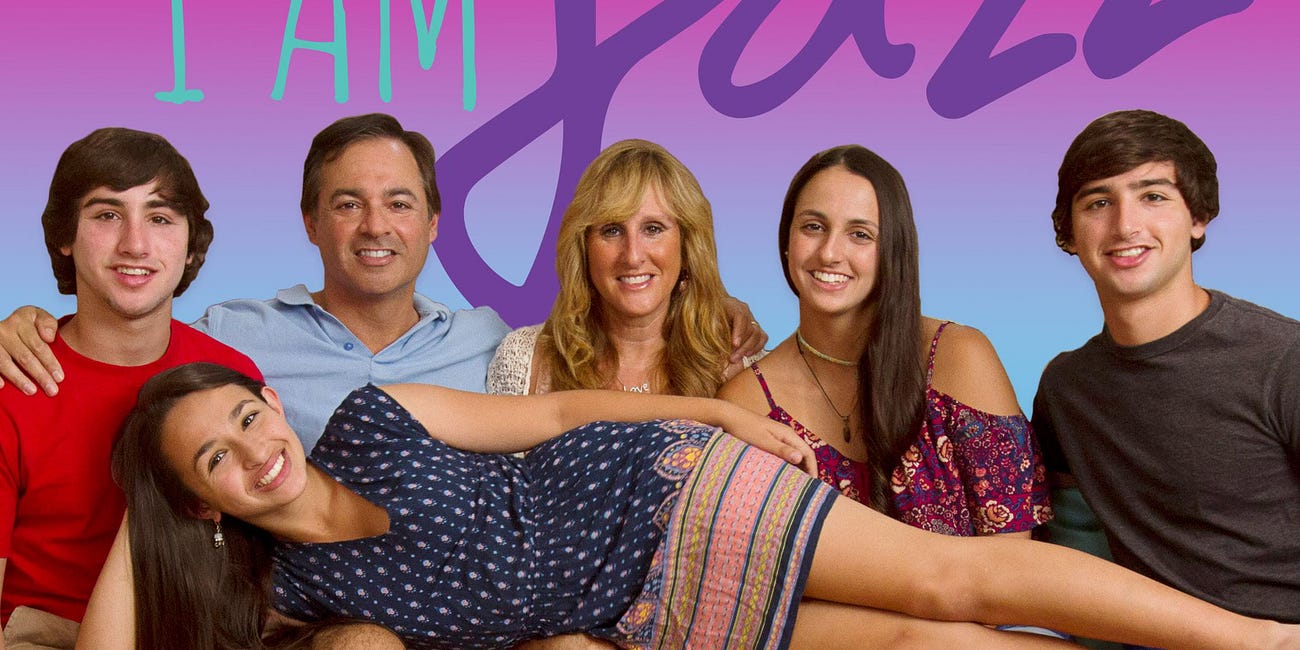
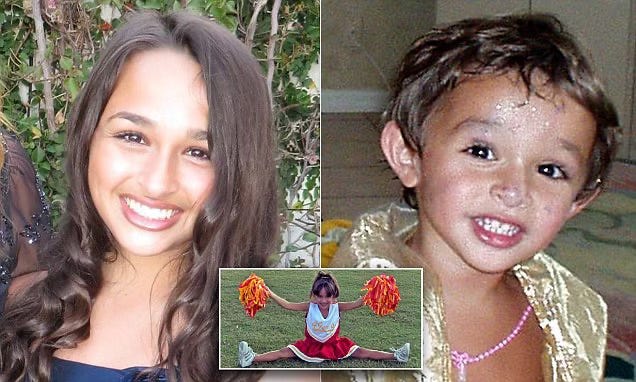
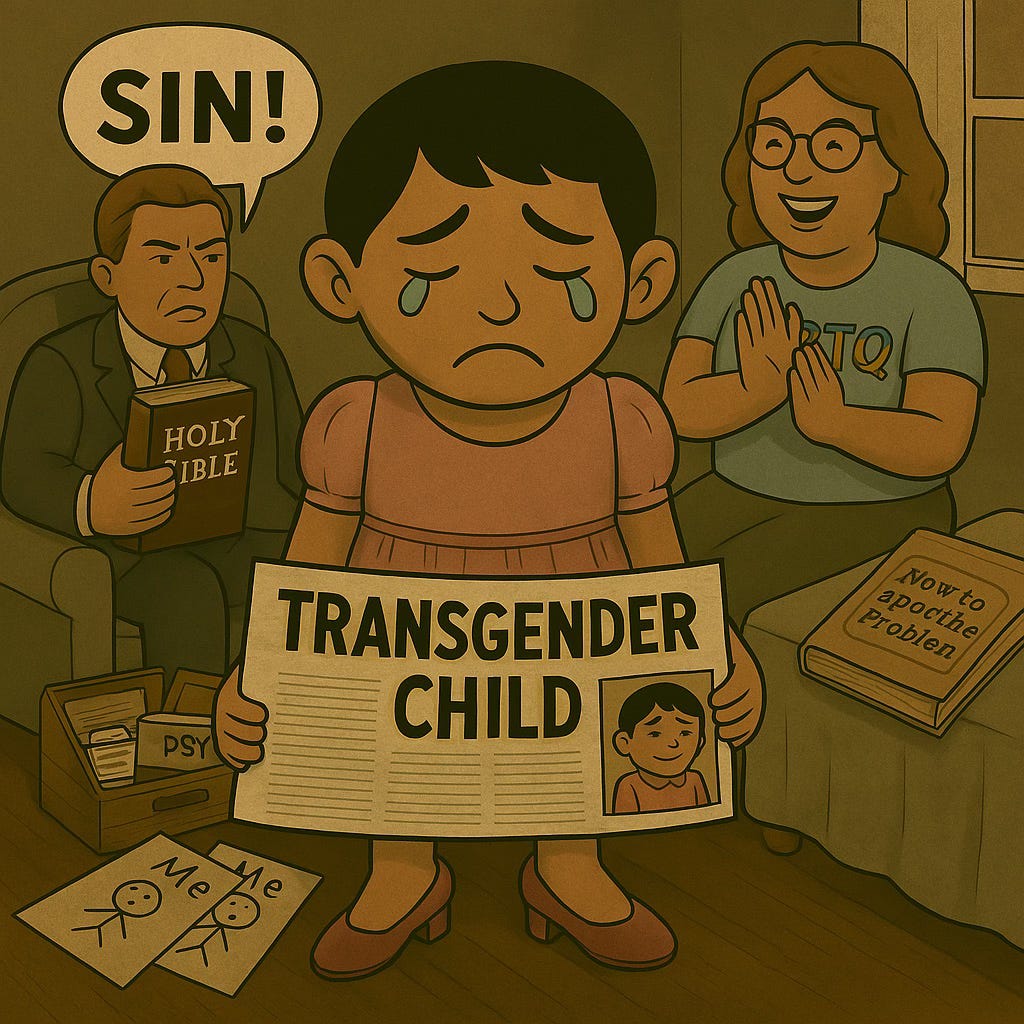
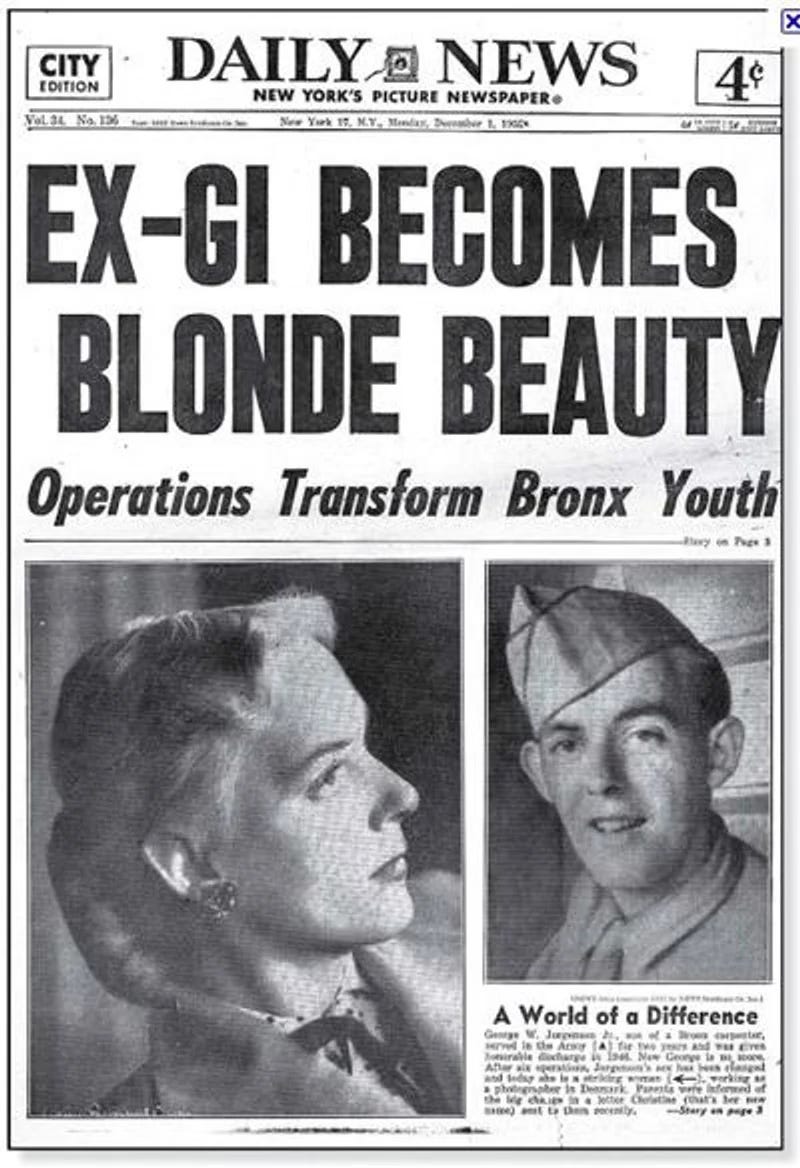

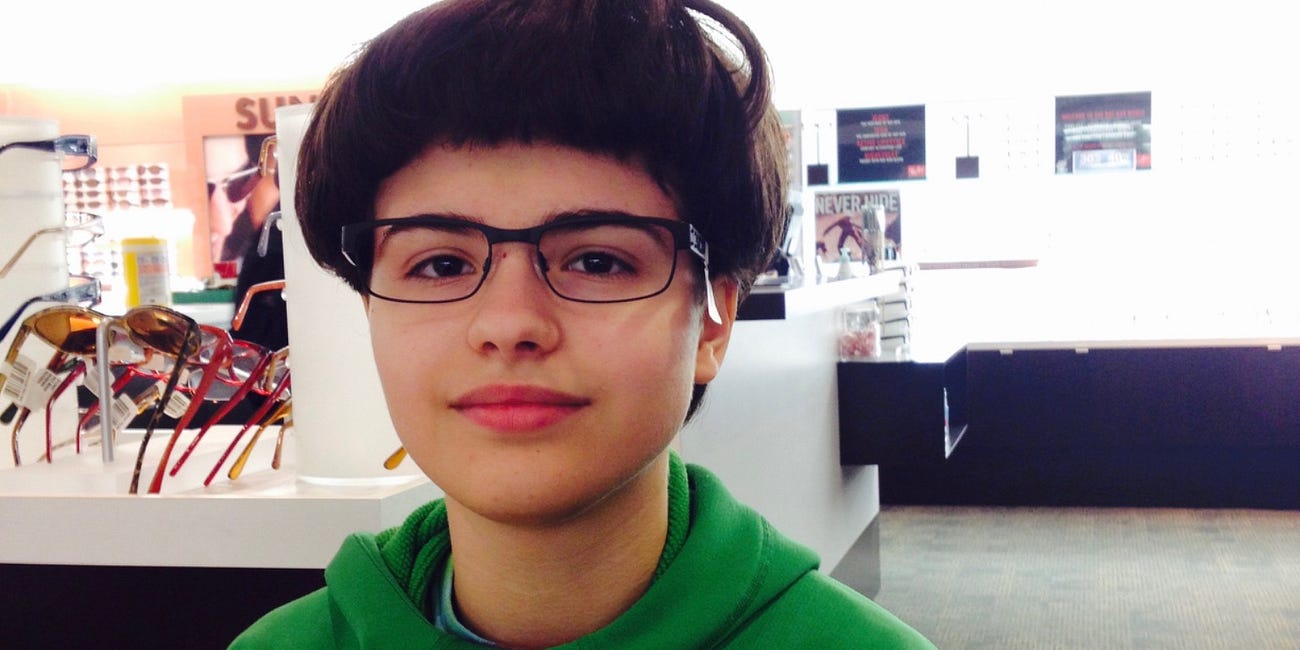
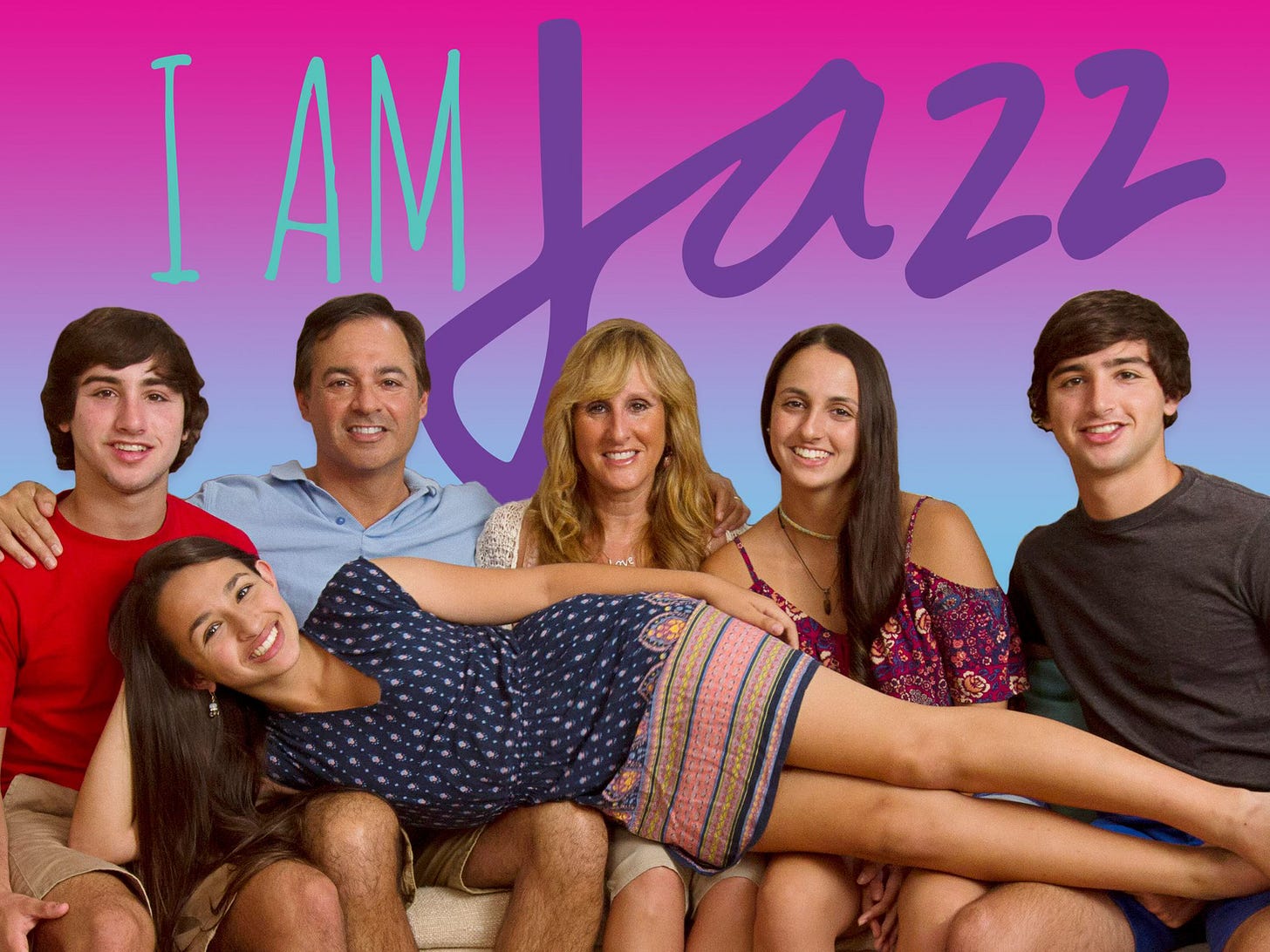
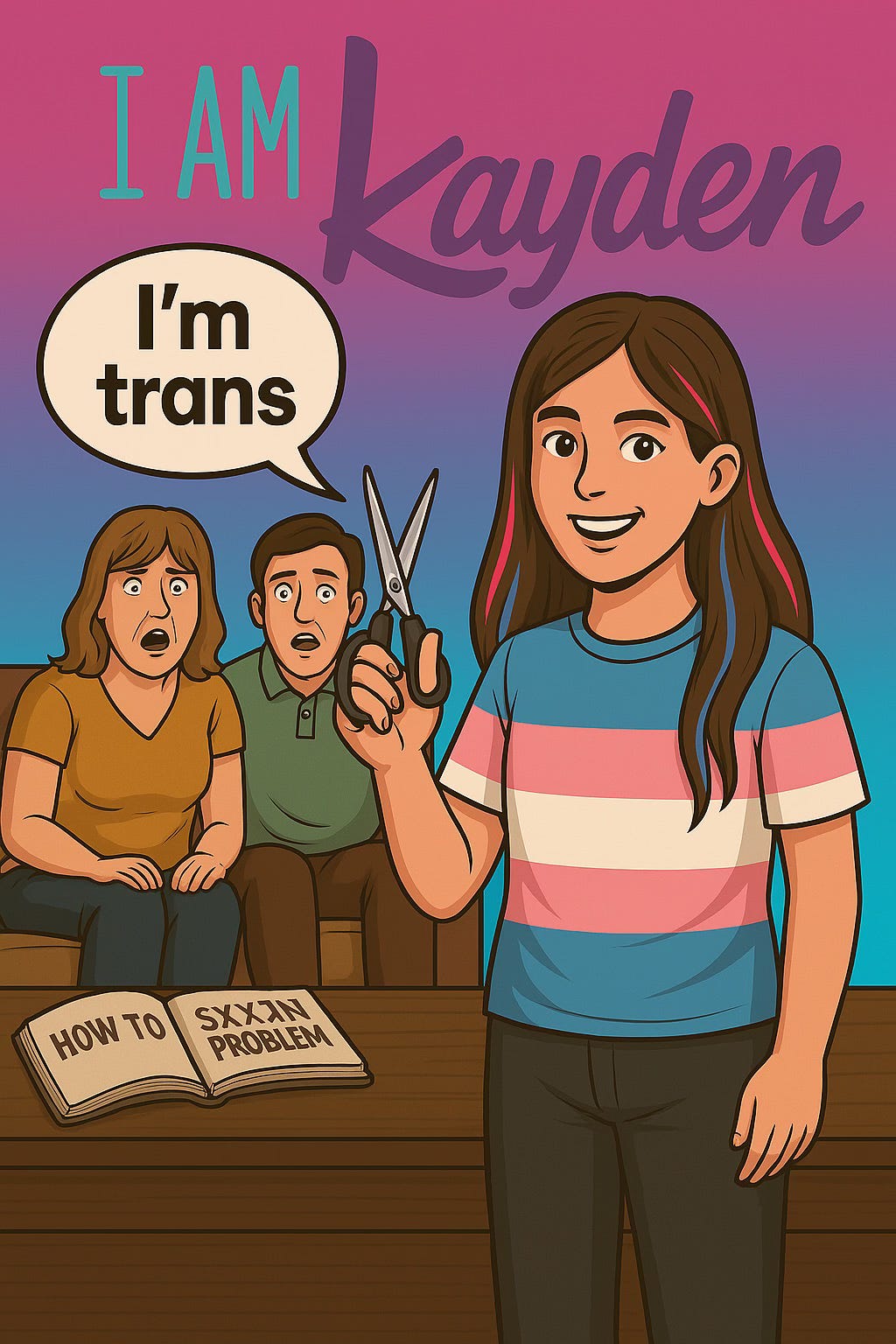
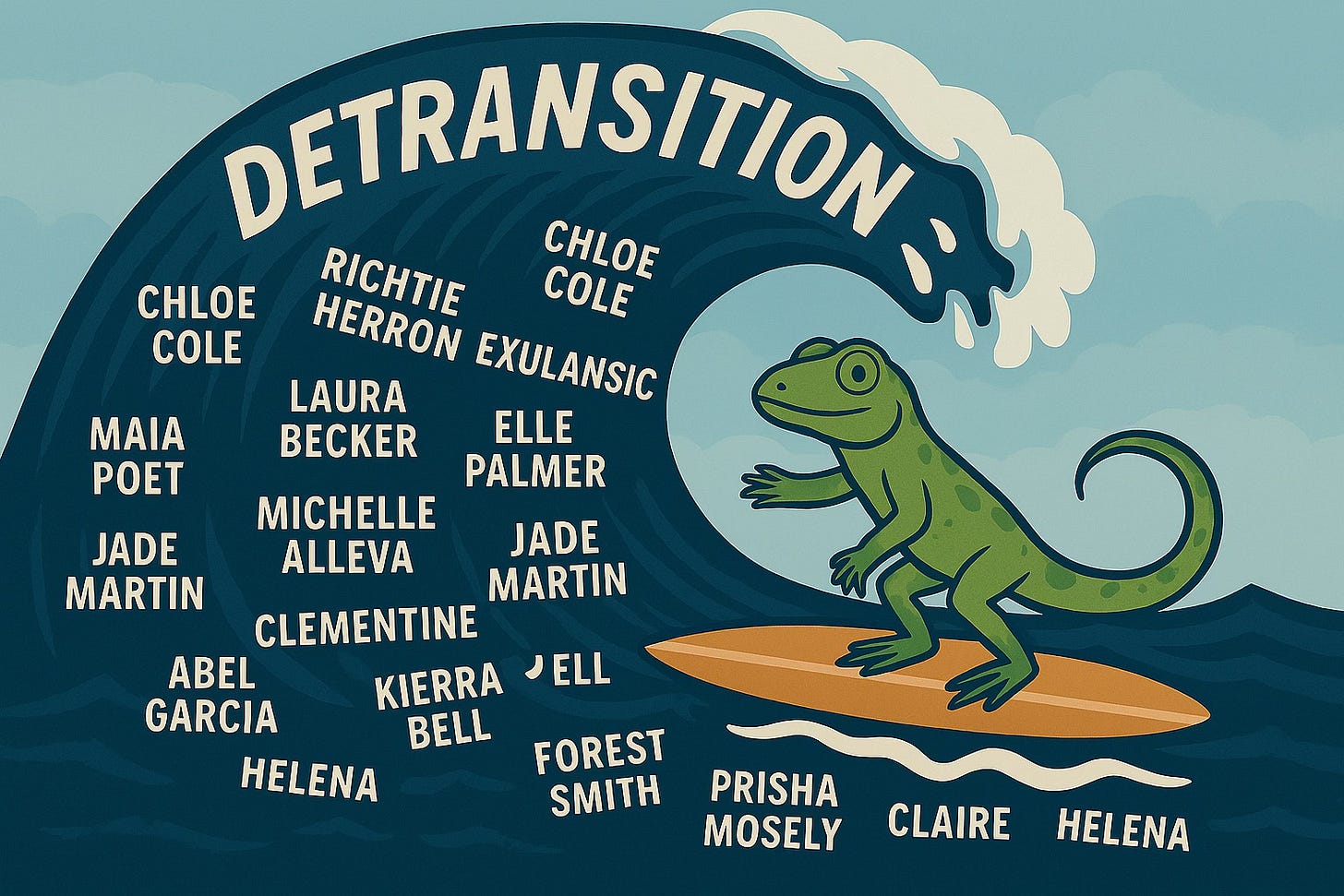

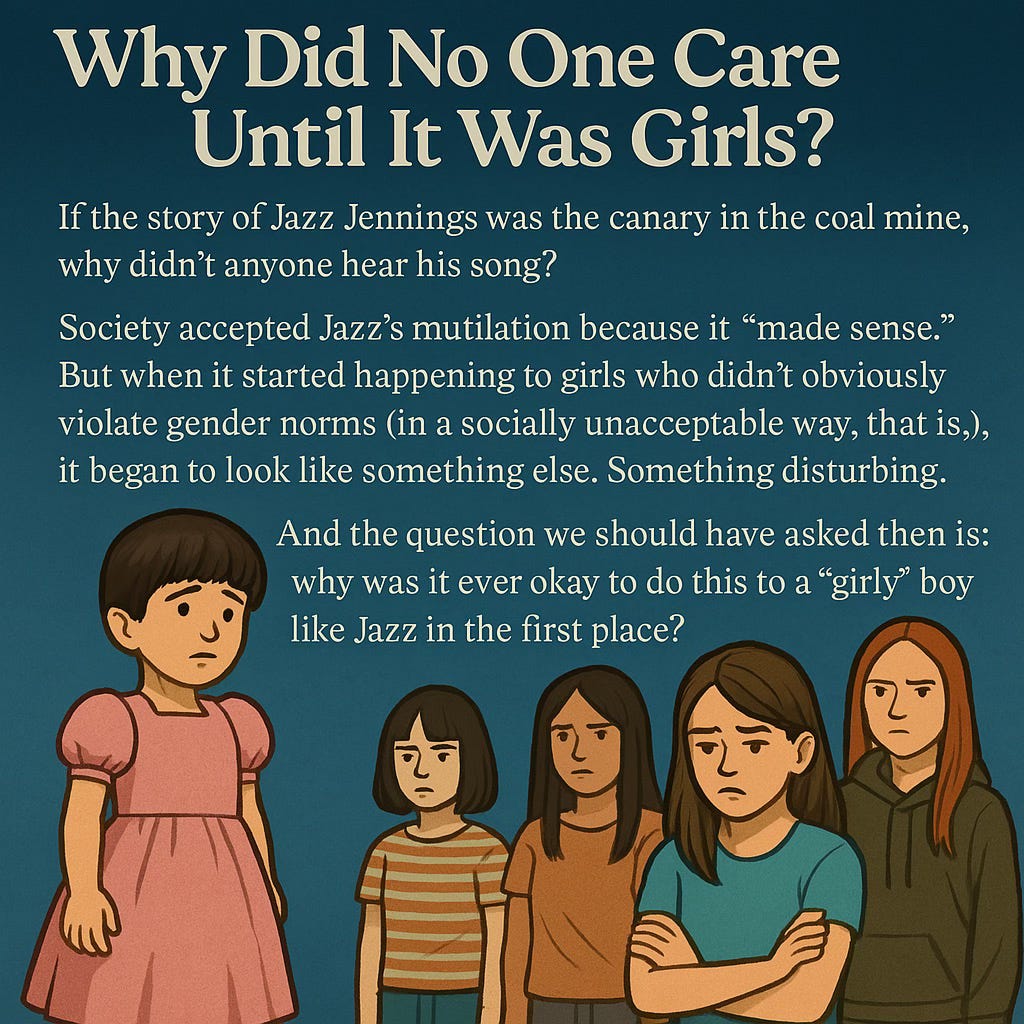
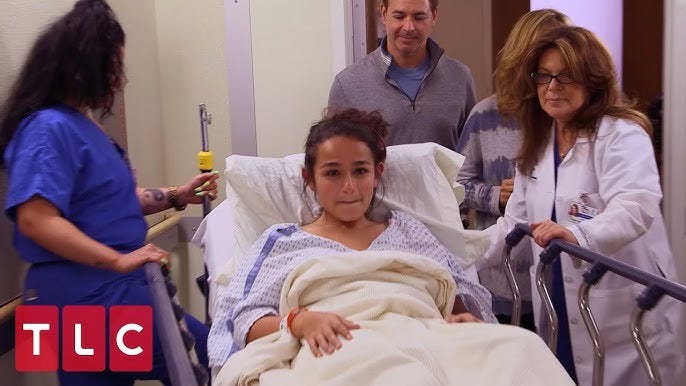


This is the most cogent analysis I’ve read of the entire phenomenon. Your voice comes from personal experience and righteous rage as well as academic rigour, and yet -- you remain grounded in compassion. We were ALL complicit as this tragedy developed. It is time to make amends and ensure that this goes down in history as a painful blip in the continuum of conscious evolution.
You’re so right. Adults said nothing…a child was castrated on tv…
Many, like me, had no idea that show was on, but if we heard mention of it, we didn’t engage in the conversation nor the thought of it.
It sounded so insane, we paid no attention.
Big mistake.
When something sounds insane and it’s on tv, adults need to inquire, pay attention, and speak up, show our shock, and shine a light on it.
I wonder what type of extreme stuff is on today that I know nothing about…